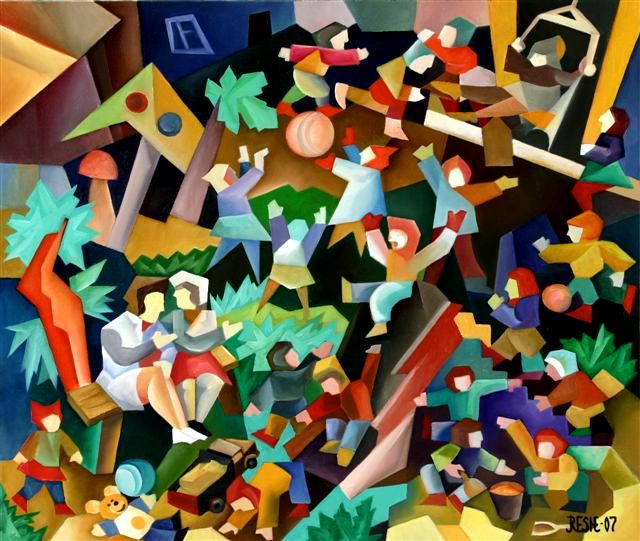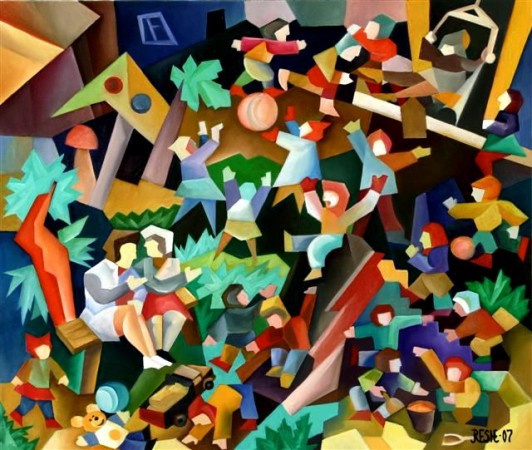Abstraction in painting.
Abstraction in art is approaching the harmony ideal, eternal image, universal ideas. Abstracting tendency manifests itself in the history of art is constantly in different forms and always points to the specific nature of the direct communication, sensory perception, and abstract thinking; observation of nature and insights of things, logical and intuitive, rational and mystical started work.
Abstraction – a mental separation, isolation of some specific elements of the set and the diversion of them from other elements of the set. This is one of the basic processes of human mental activity, based on a landmark mediation and allows to turn into an object of consideration of various properties of objects. This allows you to reflect the theoretical generalization of the basic laws of the objects or phenomena, to study them and to predict new, unknown patterns. As abstract objects are the holistic education constituting the immediate content of human thought – the notion, judgment, reasoning, laws, and other mathematical structures.
The need for abstraction is determined by the situation when they become apparent differences between the nature of the intellectual challenges and being an object in its concreteness. In such a situation a person uses, for example, the possibility of perception and describe the mountain as a geometric shape, and a moving person – as a kind of combination of mechanical levers.
Abstracting – one of the main ways of our thinking. His result – the formation of the most common concepts and propositions (abstraction). In the decorative art of abstraction – is the process of stylization of natural forms. The abstraction artistic activity is constantly present; in its extreme expression in the fine art it leads to abstract, special directions in the visual arts of the twentieth century., which is characterized by the rejection of images of real objects, limiting generalization or complete rejection of form, figurative compositions (of lines, dots, spots, and planes et al.), experiments with color, spontaneous expression of the inner world of the artist, his subconscious in chaotic, disorganized abstract forms (abstract expressionism). This direction can be attributed Kandinsky painting.
Representatives of some trends in abstract art created logically ordered structure, echoing the search for a rational organization of forms in architecture and design (Malevich Suprematism, Constructivism, and others.)
Abstract art was a response to the total disharmony of the modern world and was a success because it proclaimed a conscious rejection of the art and called “to cede the initiative forms, colors, color.”
Types of abstraction
Some types of abstraction:
primitive sensual abstraction – distracted from some properties of an object or phenomenon, highlighting its other properties or quality (emphasis form the subject, distracted by its color or vice versa). By virtue of the infinite variety of perception of reality, no not in a position to cover all its sides, so primitive sensual abstraction takes place in every process of perception and inevitably associated with it.
generalizing abstraction – gives a generalized picture of the phenomenon, distracted from private abnormalities. As a result of this abstraction is allocated common property of the objects or phenomena. This kind of abstraction is considered a major in mathematics and mathematical logic.
idealization – the substitution of the real empirical phenomena idealized scheme, distracted from the real disadvantages. As a result, the notion of an idealized form (ideal) objects (“ideal gas”, “blackbody”, “straight”, “spherical horse in a vacuum” (from a joke about the idealization), and others.)
isolating abstraction – it is closely linked to involuntary attention, because it stands out the content on which to focus.
abstraction of actual infinity – a distraction from the fundamental impossibility to fix each element of an infinite set, that is, infinite sets are considered as final.
constructivization – a distraction from the uncertainty of the boundaries of real objects, their “coarsening”.
According to the objectives of:
formal abstraction – the selection of properties of an object, which in itself and independently of it do not exist (shape or color). This type of abstraction is the basis of mastering the knowledge of children, describing the objects according to their external characteristics, which is a prerequisite of theoretical thinking.
substantial abstraction – the isolation of the properties of an object, which in itself is relatively independent (body cell).

